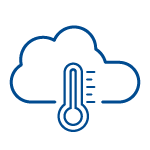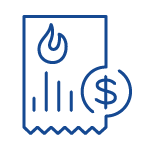We are committed to delivering affordable natural gas and work to secure the best prices for the natural gas we purchase on behalf of our residential and small business customers. Natural gas prices fluctuate based on regional and national markets, and we work diligently to secure cost-effective natural gas supplies. The cost of buying natural gas is billed to customers with no markup, meaning we do not earn additional profits from the sale of natural gas or higher supply prices.
We are here year-round to help our customers understand their bills, while also helping them prepare for colder weather and the rising costs of energy.
How We Can Help
- We offer energy-savings tools, program tips, and services to help our customers save money, use less energy, and lower their monthly bills year-round.
- If you need financial assistance, we offer a wide range of programs and services that may help you save money on your natural gas bills.
- Sign up for email and text Bill Tracker Alerts to monitor your natural gas consumption, take steps to reduce your usage, review your projected bill amount, and more.
- Eligible customers may sign up for a Level Pay Plan, which averages their annual natural gas use and costs over 12 months. Customers then pay an average bill amount each month instead of actual charges.
What Could Be Causing My SoCalGas Bill to Be Higher?
- Factors that could impact your bill include the commodity cost of natural gas (also referred to as the “core procurement gas price”), seasonal variations, an increase in your natural gas appliance usage, weather conditions, and any remaining unpaid balance from prior bills.
- The commodity cost of natural gas is just one factor that makes up the total charges on a customer’s bill. Natural Gas Transportation Rates and Public Purpose Surcharges also make up charges that customers can expect to see on their bills.
- New gas transportation rates, approved by the CPUC, went into effect on January 1, 2023. Residential average transportation rates increased by about 8% and small business transportation rate increased by about 5% on average. These transportation rate changes will allow us to continue upgrading our infrastructure, retain responsible, well-trained employees, and support the growth of diverse energy options.
Current and Historical Natural Gas Prices:
Natural gas prices change monthly, and you can view current and historical prices to help plan your usage.
Understanding Your Bill
We are all looking for ways to save time and energy and reduce expenses. Understanding your monthly SoCalGas bill can help.
What Charges Make Up My SoCalGas Bill?
Our rates are regulated and approved by the California Public Utilities Commission (CPUC). Natural gas bills consist of three cost components:
- Natural Gas Commodity Charge – The cost of natural gas purchased by SoCalGas on behalf of its customers.
- Natural Gas Transportation Rates – The cost to deliver natural gas to a customer's home or business.
- Public Purpose Surcharge – A CPUC mandated charge to fund public purpose programs such as California Alternate Rates for Energy (CARE), the Energy Savings Assistance Program, energy efficiency, and research.
Taxes and fees vary depending on customer location and applicable regulations.
Learn more about how these charges are reflected on your bills.
Factors Affecting Your Monthly Bills
Natural Gas Prices
-

The costs of purchasing and transporting natural gas can vary from year to year and within the same year. Our transportation rates, regulated by the CPUC, are typically adjusted annually at the start of each year. In some cases, these rates may change during the year as authorized by the CPUC.
Weather
-

During colder weather, natural gas usage typically increases three to seven times as we use our home heaters more often. While natural gas prices may fluctuate during warmer seasons, historical data shows lower usage. If health permits, you could save on heating costs by lowering your thermostat by three to five degrees.
Increase in Appliance Usage
-

Increased use of appliances can impact your bill. For example, water heaters work longer and harder during colder weather and could increase your natural gas usage. Having guests at home, cooking more, and leaving appliances on could also impact your bill.
Days Within Your Billing Cycle
-

There are typically 29-32 days in a billing cycle, depending on when meters are read for a particular area. However, some situations may change the number of billing days. For example, holidays can add up to four days to your billing cycle.
Past Due Amount
-

Any remaining past due amount included in your current bill will cause it to be higher.
Tools, Programs, and Tips to Manage Your Monthly Bills
Assistance Programs
We offer assistance programs for qualifying customers that could help with your bill, home energy use, and medically related heating needs.
Bill Payment Options
If you are struggling with high or past due bills, we offer payment extensions, payment plans, and other assistance.
Bill Tracker Alerts
Enroll in My Account to receive Bill Tracker Alerts via email or text to help monitor your natural gas consumption throughout the billing period. You can also learn how to analyze and lower usage to avoid surprises on your monthly bills.
Energy Savings Made Easy
Complete your Energy Profile with our Ways to Save tool to get a personalized household energy analysis and savings plan to help you keep track of your energy-efficiency progress and ultimately help you lower your bills.
Be Energy Efficient
We offer rebates on energy-efficient natural gas appliances to help you maximize your energy savings.
Stay Safe and Save Year-Round
Explore appliance safety and maintenance tips to stay safe at home and keep your appliances running smoothly.

